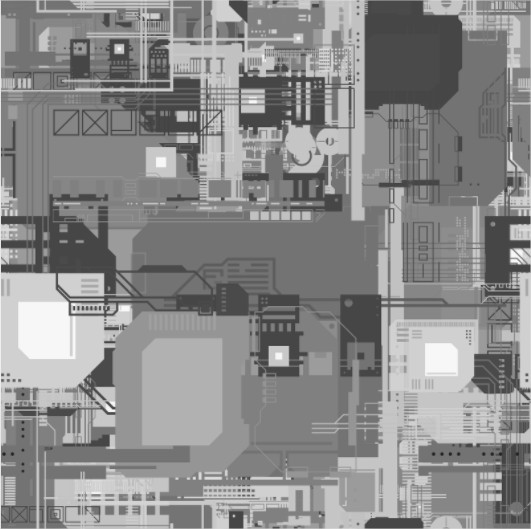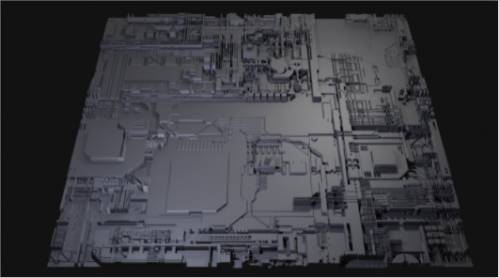Όταν πρέπει να παρέχετε στο μοντέλο σας υψηλά επίπεδα «πραγματικής» μετατόπισης μέσω της γλυπτικής ή «ζωγραφικής» αυτής της μετατόπισης, η καλύτερη λειτουργία για χρήση είναι η λειτουργία «Microvertex».
Η αντιστοίχιση mapping είναι μια εναλλακτική τεχνική γραφικών υπολογιστή σε αντίθεση με τη mapping προσκρούσεων, την κανονική mapping και τη mapping παράλλαξης, χρησιμοποιώντας έναν χάρτη υφής ή ύψους για να προκαλέσει ένα αποτέλεσμα όπου η πραγματική γεωμετρική θέση των σημείων πάνω από την επιφάνεια με υφή μετατοπίζεται, συχνά κατά μήκος της τοπικής επιφάνειας κανονικό, σύμφωνα με την τιμή στην οποία αξιολογείται η συνάρτηση υφής σε κάθε σημείο της επιφάνειας.
Δίνει στις επιφάνειες μια μεγάλη αίσθηση βάθους και λεπτομέρειας, επιτρέποντας την απόφραξη, την αυτοσκίαση και τις σιλουέτες. Από την άλλη πλευρά, είναι η πιο δαπανηρή από αυτήν την κατηγορία τεχνικών λόγω της μεγάλης ποσότητας πρόσθετης γεωμετρίας.
Ο Χάρτης μετατόπισης σάς επιτρέπει να μετακινήσετε τα σημεία πλέγματος στην επιφάνεια του βαμμένου αντικειμένου. Αυτή η τεχνική χρησιμοποιείται για τη δημιουργία βάθους χρώματος ή ανακούφισης σε σκληρή επιφάνεια. Αυτό σας επιτρέπει να σχεδιάζετε υφές με περισσότερες λεπτομέρειες και να δημιουργείτε σκιές και καθαρές σιλουέτες.
Ένας normal map χρησιμοποιείται για την προσομοίωση φωτισμού. Αυτό το εργαλείο σας επιτρέπει να δημιουργήσετε τραχύτητα και βάθος πτυχών ή βαθουλωμάτων. Η λειτουργία σάς επιτρέπει επίσης να προσθέσετε πολλές μικρές λεπτομέρειες στο τρισδιάστατο μοντέλο.
Η μετατόπιση λειτουργεί μόνο όταν υπάρχει αρκετή γεωμετρία (όψεις) στην επιφάνεια του αντικειμένου για να μετακινήσετε τις μεμονωμένες κορυφές προς τα πάνω ή προς τα κάτω με βάση το χρώμα του εικονοστοιχείου στον χάρτη ύψους.
Εάν ο σχεδιαστής χρησιμοποιεί ένα μοντέλο low-poly, ο χάρτης μετατόπισης και τα εφέ που δημιουργεί είναι πρακτικά αόρατα. Επομένως, ένα τόσο λεπτομερές σχέδιο δεν έχει νόημα σε αυτή την περίπτωση. Το πλήρες δυναμικό αποκαλύπτεται όταν εργάζεστε με ένα μοντέλο υψηλής ποιότητας.
Σε αυτήν την προσέγγιση, κάθε πρόσωπο (επιτρέπεται μόνο το τετραπλό) αντιπροσωπεύτηκε ως ένα μπάλωμα από κορυφές N x M (το N και το M θα μπορούσαν να είναι διαφορετικά για κάθε πρόσωπο).
Κάθε κορυφή είχε χρώμα και συντεταγμένες στο διάστημα, οπότε επιτρεπόταν οποιαδήποτε μετατόπιση. Ωστόσο, αυτή η προσέγγιση ήταν περιορισμένη επειδή ήταν πολύ δύσκολο να επεξεργαστείτε πλέγμα με μη τετράπλευρες όψεις. Η προβολή του patch στην υφή είχε ως αποτέλεσμα την απώλεια ποιότητας, επομένως ήταν δύσκολο να import μια υφή, να την επεξεργαστείτε και στη συνέχεια να την export , επειδή η υφή μετά την εξαγωγή φαινόταν ελαφρώς θολή. Έτσι αποφασίσαμε να εφαρμόσουμε τη ζωγραφική per-pixel .
Αυτή η λειτουργία σάς επιτρέπει να export τυπικούς ή διανυσματικούς χάρτες μετατόπισης που αντικατοπτρίζουν με ακρίβεια τα πιο ακραία επίπεδα μετατόπισης που έχετε προσθέσει μέσω υφών ή γλυπτικής.
Η ζωγραφική Micro-Vertex (μετατόπιση) στην πραγματικότητα τροποποιεί ένα προσωρινό "πλέγμα προβολής", το οποίο είναι μια υποδιαιρεμένη έκδοση του βασικού σας πλέγματος που ορίζεται από τον χρήστη, εφαρμόζοντας πραγματική και πραγματική μετατόπιση σε αυτό το προσωρινό πλέγμα.
Κατά την export του μοντέλου σας και των σχετικών υφών του, σας δίνεται η επιλογή να ορίσετε την πυκνότητα τελικού πλέγματος. Για να διασφαλίσετε ότι το μοντέλο σας μπορεί να αντιπροσωπεύει με ακρίβεια τη μετατόπιση που επιτυγχάνεται σε πραγματικό χρόνο στο παράθυρο προβολής, βεβαιωθείτε ότι του δίνετε επαρκή πυκνότητα πολυγώνων (10′ ή εκατοντάδες χιλιάδες πολύγωνα).
Το 4M είναι εντάξει για έναν χάρτη υφής 2k. Για έναν χάρτη 4k, πηγαίνετε όσο πιο ψηλά μπορείτε.
Φροντιστήρια
Painting με υφές πολλαπλών πραγματικών μετατοπίσεων (Η γρήγορη εξήγηση) : Αυτός είναι ένας γρήγορος οδηγός για το πώς να ζωγραφίζετε με μετατόπιση Tessellated χρησιμοποιώντας τις απίθανες υφές 4-8K του Christoph Schindelar “Real Displacement Textures” σε 3DCoat. Επιπλέον, μπορείτε να χρησιμοποιήσετε το IBL (φωτισμός βάσει εικόνας) για να φωτιστεί το μοντέλο σας από την εικόνα φόντου για να έχει την εμφάνιση που ανήκει στη φωτογραφία αλλά και να σας βοηθήσει να οραματιστείτε τη δημιουργία σας.
Import σε Επιλογές Microvertex Σημειώσεις : Αυτό το βίντεο αναφέρει μερικές γρήγορες και σημαντικές σημειώσεις σχετικά με την εισαγωγή ενός μοντέλου στο Painting Room χρησιμοποιώντας την επιλογή MicroVertex (displacement map ).
Τι είναι οι χάρτες μετατόπισης; από τον Chipp Walters , το Displacement λειτουργεί μόνο όταν υπάρχει αρκετή γεωμετρία (όψεις) στην επιφάνεια του αντικειμένου για να μετακινηθούν οι μεμονωμένες κορυφές προς τα πάνω ή προς τα κάτω με βάση το χρώμα του pixel στον χάρτη ύψους.
Η μετατόπιση είναι όπου χρησιμοποιείτε μια εικόνα σε κλίμακα του γκρι για να δημιουργήσετε σημαντική τοπολογία.
Ακολουθεί ένα παράδειγμα ενός «χάρτου» σε κλίμακα του γκρι. Σημείωση Χρησιμοποίησα την υπέροχη (και δωρεάν) εφαρμογήJSplacement για να δημιουργήσω αυτήν .

Μπορείτε να δείτε όταν ένας displacement map εφαρμόζεται σωστά, οι φωτεινές περιοχές στην εικόνα κλίμακας του γκρι είναι «υψηλότερες» από τις πιο σκούρες περιοχές.

 Ελληνικά
Ελληνικά  English
English Українська
Українська Español
Español Deutsch
Deutsch Français
Français 日本語
日本語 Русский
Русский 한국어
한국어 Polski
Polski 中文 (中国)
中文 (中国) Português
Português Italiano
Italiano Suomi
Suomi Svenska
Svenska 中文 (台灣)
中文 (台灣) Dansk
Dansk Slovenčina
Slovenčina Türkçe
Türkçe Nederlands
Nederlands Magyar
Magyar ไทย
ไทย हिन्दी
हिन्दी Tiếng Việt
Tiếng Việt Lietuviškai
Lietuviškai Latviešu valoda
Latviešu valoda Eesti
Eesti Čeština
Čeština Română
Română Norsk Bokmål
Norsk Bokmål